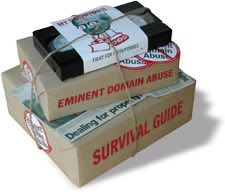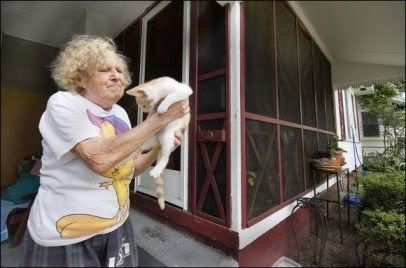Back on my kick about “blight” and “eminent domain”.
Earlier I posted this diary.
Eminent domain is all about the meaning of “blight.”
It goes into the way it is mostly done in Florida, as well as a few other states. The secret words are Community Redevelopment Agencies…CRAs. They are able to grasp control of areas they decide are blighted, and they appear to have the power of eminent domain in the name of city planning. Do a search. Florida is filled with them, even more than the last time I searched on the term. Many of the websites for city agencies look brand new.
This time I found a Florida newspaper is concerned as well with the implications of who gets to define blight. This is the key here in Florida, and apparently in other states, the definition of blight. Later I will post Florida’s critieria. First the article.
Eminent domain abuse should worry Floridians
“Florida home and business owners were in grave danger before Kelo, and they are even worse off now. Despite repeated claims by the attorney general and others, Florida citizens have very little protection against eminent domain abuse.
The U.S. Supreme Court took away what little protection they might have had by ruling that the U.S. Constitution is no barrier to the use of eminent domain for private profit.”
“Florida municipalities routinely use eminent domain to take property for private development or to intimidate the rightful owners into selling “voluntarily.” Boynton Beach, Daytona Beach, Fort Lauderdale, Jacksonville Beach, Jacksonville, Charlotte County, Riviera Beach and West Palm Beach all have used or threatened eminent domain for private development in the past five years.
The justification is always that the current homes and businesses are too shabby (i.e. “blighted”), and something newer and more expensive would be a better use of the land.”
Then the Tallahassee Democrat offers a website that has been set up to help homeowners fight. It is called Castle Coalition

It has a great kit for homeowners called The Eminent Domain Abuse Survival Guide.

It is designed to give practical suggestions for attacking the condemnation of your property outside of the courtroom.
Our city presently has 4 CRAs. They are all older neighborhoods near business districts, but they are not all blighted. Some are poor neighborhoods with high crime, but in the middle there are pockets of well-kept homes. Not fancy, but loved and cared for by their owners.
The picture of this lady moved me so when I saw it in our paper. Her home was bought by the CRA apparently, but I doubt she knew who they were. They told her rent would never go up as long as she was alive….I guess they failed to tell her home was being destroyed to make room for high-priced condominiums. She said they could just shoot her if she had to leave.

From the website of a CRA in Fernandina Beach, Florida, here is the Florida definition of “blight”. I believe the Tallahassee article refers to the fact that now there need only be one of these to qualify, before there were two. I may have misunderstood.
(8) “Blighted area” means an area in which there are a substantial number of deteriorated, or deteriorating structures, in which conditions, as indicated by government-maintained statistics or other studies, are leading to economic distress or endanger life or property, and in which two or more of the following factors are present:
(a) Predominance of defective or inadequate street layout, parking facilities, roadways, bridges, or public transportation facilities;
(b) Aggregate assessed values of real property in the area for ad valorem tax purposes have failed to show any appreciable increase over the 5 years prior to the finding of such conditions;
(c) Faulty lot layout in relation to size, adequacy, accessibility, or usefulness;
(d) Unsanitary or unsafe conditions;
(e) Deterioration of site or other improvements;
(f) Inadequate and outdated building density patterns;
(g) Falling lease rates per square foot of office, commercial, or industrial space compared to the remainder of the county or municipality;
(h) Tax or special assessment delinquency exceeding the fair value of the land;
(i) Residential and commercial vacancy rates higher in the area than in the remainder of the county or municipality;
(j) Incidence of crime in the area higher than in the remainder of the county or municipality;
(k) Fire and emergency medical service calls to the area proportionately higher than in the remainder of the county or municipality;
(l) A greater number of violations of the Florida Building Code in the area than the number of violations recorded in the remainder of the county or municipality;
(m) Diversity of ownership or defective or unusual conditions of title which prevent the free alienability of land within the deteriorated or hazardous area; or
(n) Governmentally owned property with adverse environmental conditions caused by a public or private entity.
“However, the term “blighted area” also means any area in which at least one of the factors identified in paragraphs (a) through (n) are present and all taxing authorities subject to s. 163.387(2)(a) agree, either by interlocal agreement or agreements with the agency or by resolution, that the area is blighted. Such agreement or resolution shall only determine that the area is blighted. For purposes of qualifying for the tax credits authorized in chapter 220, “blighted area” means an area as defined in this subsection.”




